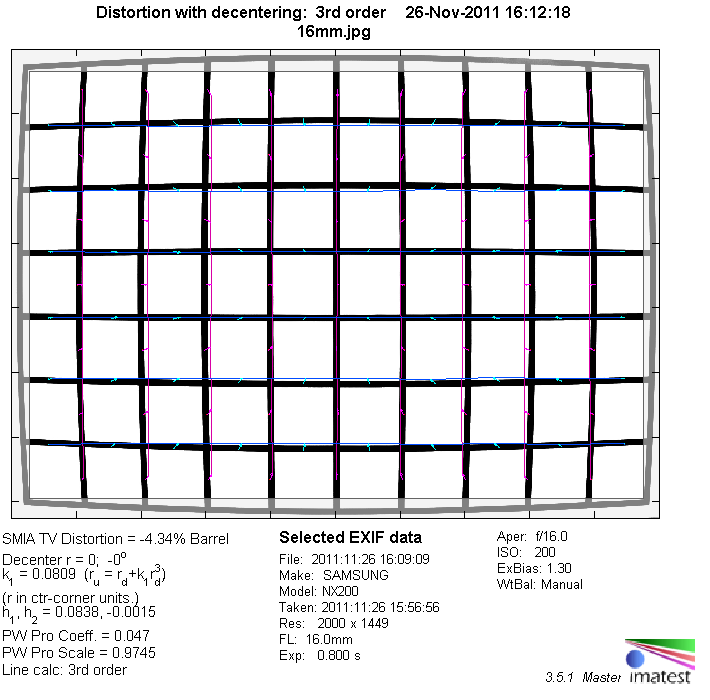|
Samsung NX 16mm f/2.4 ( W16NB ) - Review / Test Report - Analysis |
|
Lens Reviews -
Samsung NX
|
|
Page 2 of 3

Distortion
Lens distortion is usually auto-corrected either in the camera directly or in Capture One (Samsung's RAW converter). However, it is possible to disable this feature in the RAW converter.
The native distortion characteristic of the NX 16mm f/2.4 is rather poor. A barrel distortion of ~4.3% is certainly a show-stopper e.g. for serious architecture photography although it a lesser issue for landscapes and such. That said most people will prefer an activated auto-correction anyway.

Vignetting
The NX 16mm f/2.4 is a fairly "fast" pancake lens and combined with the wide field-of-view it's not overly surprising that it vignettes quite a bit at fully open aperture. A light fall-off of 1.3EV will be visible in many scenes. Stopping down a little improves the issue but is it only reasonably well-controlled from f/4 onward.

MTF (resolution)
The resolution characteristic of the NX 16mm f/2.4 is pretty wild. The center performance is excellent even at max. aperture. However, the borders/corners are a different story - they are plain soft here. Stopping down to f/3.2 improves the borders quite a bit but the corners remain very soft at this setting. The situation changes drastically at f/4 where the outer region is boosted to very good quality levels. This is kept till f/11.
Please note that the MTF results are not directly comparable across the different systems!
Below is a simplified summary of the formal findings. The chart shows line widths
per picture height (LW/PH) which can be taken as a measure for sharpness.
If you want to know more about the MTF50 figures you may check out the corresponding
Imatest Explanations
Field Curvature
In the previous chapter we showed you the performance on the focus plane. Normally we can assume that the focus plane is just that - a plane. However, this is actually never really the case. The focus field is a (hopefully) center-point symmetrical sphere but a quite chaotic one. Usually this is not an issue but sometimes the field curvature gets too extreme and, unfortunately, the NX 16mm f/2.4 has an issue here. Now, the outer region isn't overly sharp at f/2.4 and f/3.2 anyway so the additional field curvature isn't really relevant anymore. However, if you want to have a sharp depth-of-field you should stop down beyond f/8.
The effect of the field curvature is highly dependent on the chosen aperture and especially focus distance - which simply defines the depth-of-field for a give focal length - so it is difficult to quantify the effect. Below is the quality curve for a distance of about ~3m - just to give you an idea. In the sample image section we've provide a sample scene at f/5.6 and f/11 respectively which illustrates the effect.
On the NX 16mm f/2.4 the field curvature favors the foreground - the focus in the outer zone is pulled towards you so you are loosing focus at far distances. The issue is a bit less pronounced with ACTIVATED distortion correction simply because a good portion of the defocused corners are cropped away.
This may look dramatic and unless you take countermeasures it usually is. You can compensate the problem to some degree if you push the focus towards the back thus also pushing the border/corner focus towards the background as well. You can, for instance, do so by using "selection AF" and move the focus area to the very left or right image side pointing to at least a mid field object.
We tested two samples of the lens and both suffered from field curvature. Other users reported similar findings to us so this issue is not an exception to the rule on this lens.
Chromatic Aberrations (CAs)
Lateral chromatic aberrations (color shadows at the image borders) are quite well-controlled for a moderate ultra-wide angle lens. The average CA pixel width is around 1px on the average at the image corners which can be visible but not overly disturbing.

|